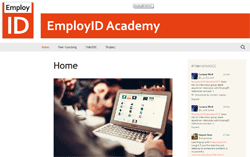 HCII is one of the largest HCI conferences, which this year (10 – 14. Jul. 2017) took place in Vancouver, Canada. The conference location was right on the waterfront with a spectacular view of the harbour. The conference included 1,228 papers (with an acceptance rate of 28%). ZSI presented a paper on user experiences around semantic analysis, part of the learning analytics work in EmployID.
HCII is one of the largest HCI conferences, which this year (10 – 14. Jul. 2017) took place in Vancouver, Canada. The conference location was right on the waterfront with a spectacular view of the harbour. The conference included 1,228 papers (with an acceptance rate of 28%). ZSI presented a paper on user experiences around semantic analysis, part of the learning analytics work in EmployID.
We had the opportunity to present some research we did at ZSI (Christian Voigt, Barbara Kieslinger and Teresa Schäfer) on the use of sentiment analysis to support workplace learning. During the presentation, we shortly summarized the context of our research, i.e. training for employment service agencies (http://employid.eu/). Together with four other presentations on social computing in collaborative learning settings, our paper fitted well the general discussion of peer learning and how technology could facilitate the discourse among learners, improving quality and engagement of their interactions.
During the conference, we had good conversations around the paper itself, as well as HCI research design in general. There was general agreement that sentiment analysis has multiple application possibilities when it comes to learning, especially if we remember the importance of learners’ emotional engagement and the affective dimension of learning. There were also many comments on our study design, primarily using interviews with end-users around mock-up visualisations. The main criticism, which we take on board for future studies, was the short time end-users had to form an opinion on the value of features or to reflect on the ways they could use the visualisations. Interaction designers commented that end-users need some exposure to an interface before they can judge a tool and not be overly influenced by the tool’s novelty or some distracting glitches. Some were also recommending that we should explicitly test whether users would understand the sentiment visualisations in their own rights or whether they were primarily reacting to the explanations given in the interviews. That’s a fair point and we will need to see how that can be achieved.
A preprint version and the presentation can be found here:
https://www.researchgate.net/publication/315810440_User_Experiences_Arou...
And the presentation is here:
https://de.slideshare.net/chrvoigt/user-experiences-around-sentiment-ana...
DOI: https://doi.org/10.1007/978-3-319-58562-8_24
Voigt, C., Kieslinger, B., & Schäfer, T. (2017). User Experiences Around Sentiment Analyses, Facilitating Workplace Learning. In G. Meiselwitz (Ed.), Social Computing and Social Media. Applications and Analytics: 9th International Conference, SCSM 2017, Held as Part of HCI International 2017, Vancouver, BC, Canada, July 9-14, 2017 (pp. 312–324). Springer International Publishing.




